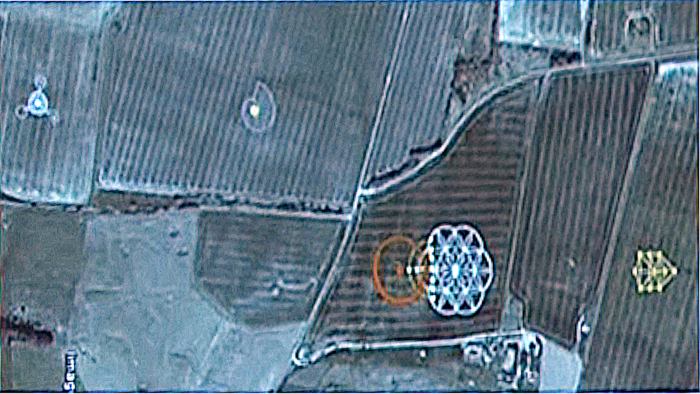Pictograms
| Wiki Pages (this site) |
- HomePage Abstraction Physics
- Pictograms <-- You Are Here!
- IQCommandExamples
- AbstractionPhysicsRegardingPhilosophy
- AnotherAttemptToBringInSoftwarePatentsInEurope
The following overview image resolution is low, for image details and description, continue...

'User Interface Diagram (UID) Focus'
Watch Simon Miles Bases Lecture on his recognition of the basic association of the Crop Circles.
NOTE: the youtube account of Simon Miles has been removed, so here's a single frame from the video showing all the crop circles listed.

All these are in the general area/fields of the Barbury Castle at the lower left corner of the image.
Barbury Castle crop circle, July 17th, 1991 at far left (special note: this is considered important as being the first complex crop circle of all crop circles)
Tree of Life crop circle, May 8th, 1997 at far right and center line aligned to the cluster of the Flower of life, Menorah, and Pi crop circles.
Menorah crop circle, May 31st, 1999 at center of cluster with its Scrab at the center of Flower of Life and its base at the center of Pi.
Flower of Life crop circle, July 28th, 2003 at right side of cluster.
Small Shell crop circle, July 14th, 2006 at Second from left of image.
Pi crop circle, June 1st, 2008 At left side of cluster.
Also refer to the topic of this Wiki Site Abstraction Physics to best understand how these pictograms are used here to express human focus and interaction between (referring to pictograms green lines or wiki's upper left pictogram) the conscious mind (outer circle of three in the center), subconscious (middle circle of three in the center), and body clock (center circle of three in the center). Straight lines represent relationships between these three and the three outer positions or modes of human focus of place-value, resolution, and recursion.
NOTE: What is most relevant in Simons's presentation is not his narrative but of the crop circles and their relevant location over time, inclusive of even the shell crop circle which is representative of a small shell program of the Virtual Interaction Configuration commands. As to the Tree of Life crop circle, I believe the Barbury Castle crop circle is a condensed version of it, even stating such before I knew of all these crop circles' field placement relationships that Simon discovered.
He clearly places/associates the flower of life and pi crop circles on the 1991 Barbury crop circle. The Menorah he orients on the 1991 cc but should be turned to line up with the third part of 1991, as the initial setting. There is intent to turn, depending on user accessed interface & focus.
'UID Initial Position'
Place-value, resolution, and recursion. In this case, the resolution is "6" (flower of life with six petals/positions), the recursion is expressed as pi (pi cc) being that it is infinite as is pi calculated. Additionally, the pi cc has an association with both the rings of the 1991 cc and scarab position. The Menorah, seven flames as there are seven action constants of abstraction physics (ten total. Note: pi cc is calculated to ten places). There are three additional nodes on the menorah. Abstraction physics has two of the ten as just settings for where input and output are set. The remaining one of the ten represents definitions (inherent in the use of the nine). The nodes on the menorah are placeholders for the action constants of abstraction physics. Configured as needed.
There is the scarab & base of the menorah. The base being the user and what interface(s) they are accessing (in this case: place-value), the scarab being the user's point of focus. When between two of the 1991 cc triangle points, the user accessed interface or focus is on the relationship of the two it is between.
Food for thought: Flower of life (upper left) = Physical Reality; Pi (upper right) = Recursion; bottom center = Abstraction.
What side might disconnection from physical reality happen?
The following image links will open a new tab for each (broken - use the right mouse button to open links). By zooming your tab windows the same you can click on the tabs to see something of an animation.
The links are relative in position to the overview above.
The reason for the position of CC1 being the first in the set is to give emphasis on the human ability to abstract. In position CC6, CC12 & CC18, the individual is considering abstraction and recursion in their perception of physical reality. What they then communicate in an abstract form about reality to others is inherently limited to the receiver's abstract definition and its association to physical reality. There is a translation that takes place.
Copyright (C) 2014, 2017, 2021 Timothy Rue
This work is licensed under the Creative Commons Attribution 4.0 International License.
To view a copy of this license, visit http://creativecommons.org/licenses/by/4.0/